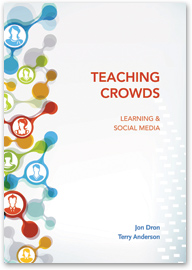Book Review: Teaching Crowds

Crowds. They are everywhere, and generally crowds cause challenges for those that have to manage them. Yet, crowds can be exciting, energetic, and full of creativity. Trying to manage the complexities of a crowd, while harnessing the positive potential of a crowd can be especially tricky in an instructional context.
One of the most exciting (yet daunting) recent pushes in education is the call for using social media and social learning to connect with crowds. Whether this be a MOOC with tens of thousands of people, or teaching a distance course to a smaller group, teaching crowds can be a wonderful challenge. Teaching Crowds: Learning and Social Media  by Jon Dron and Terry Anderson is a recent book aimed to address this current teaching challenge. This book is part of the series, Issues in Distance Education, edited by Terry Anderson and David Wiley.
by Jon Dron and Terry Anderson is a recent book aimed to address this current teaching challenge. This book is part of the series, Issues in Distance Education, edited by Terry Anderson and David Wiley.
Note: Jon Dron was a keynote speaker at E-Learn 2015 in Montreal.
In this book, Dron and Anderson give practical advice for dealing with teaching crowds of all sizes. In the first two chapters, they discuss the nature and value of social software and the rise of the internet as well as a general explanation of social learning theories. While these chapters are still useful for those with many years of online instructional experience, they become a valuable resource for novices that are just entering the world of online and social learning.
Excerpt from Dron and Anderson’s, Teaching Crowds:
By definition, learning is associated with change. We change our ideas, actions, capacities and skills in response to challenges and opportunities. For most types of learning, the necessary knowledge or skills needed to solve our problem already exists in the mind of another person or resource. Our job as learners and educators is to provide tools, paths, and techniques by which this knowledge can be accessed, appropriated, constructed, and re-constructed so as to meet our individual and collective needs. (2014, p. 10)
The early chapters provide a basis for why understanding teaching crowds is important. The middle chapters provide an explanation of several kinds of crowds (groups vs. networks. vs sets) and are again, a great resource for anyone that is involved in teaching crowds of most any size and form. The authors then provide stories and examples of how to teach crowds, discuss issues and challenges of technology and social software when dealing with crowds. Finally, the authors discuss and make some predictions on what the future of social teaching and learning may look like.
There is much to gain from reading this book if you are currently instructing a crowd of any size, or if you plan to in the future.
This book is available for purchase in paper back, a variety of electronic formats, and is also available FOR FREE as a PDF from their website http://teachingcrowds.ca/. More information about the book and series can also be found on that page.
